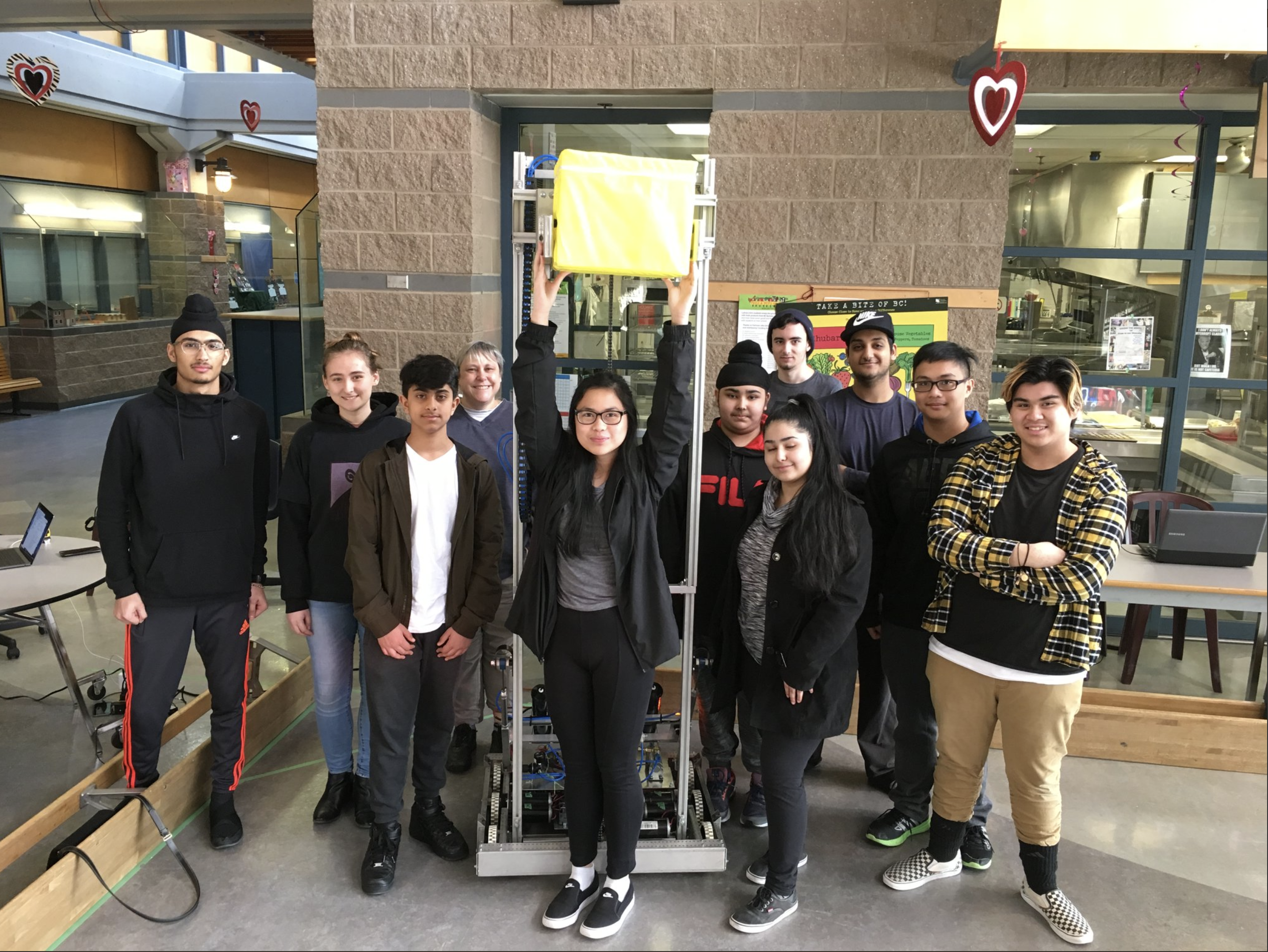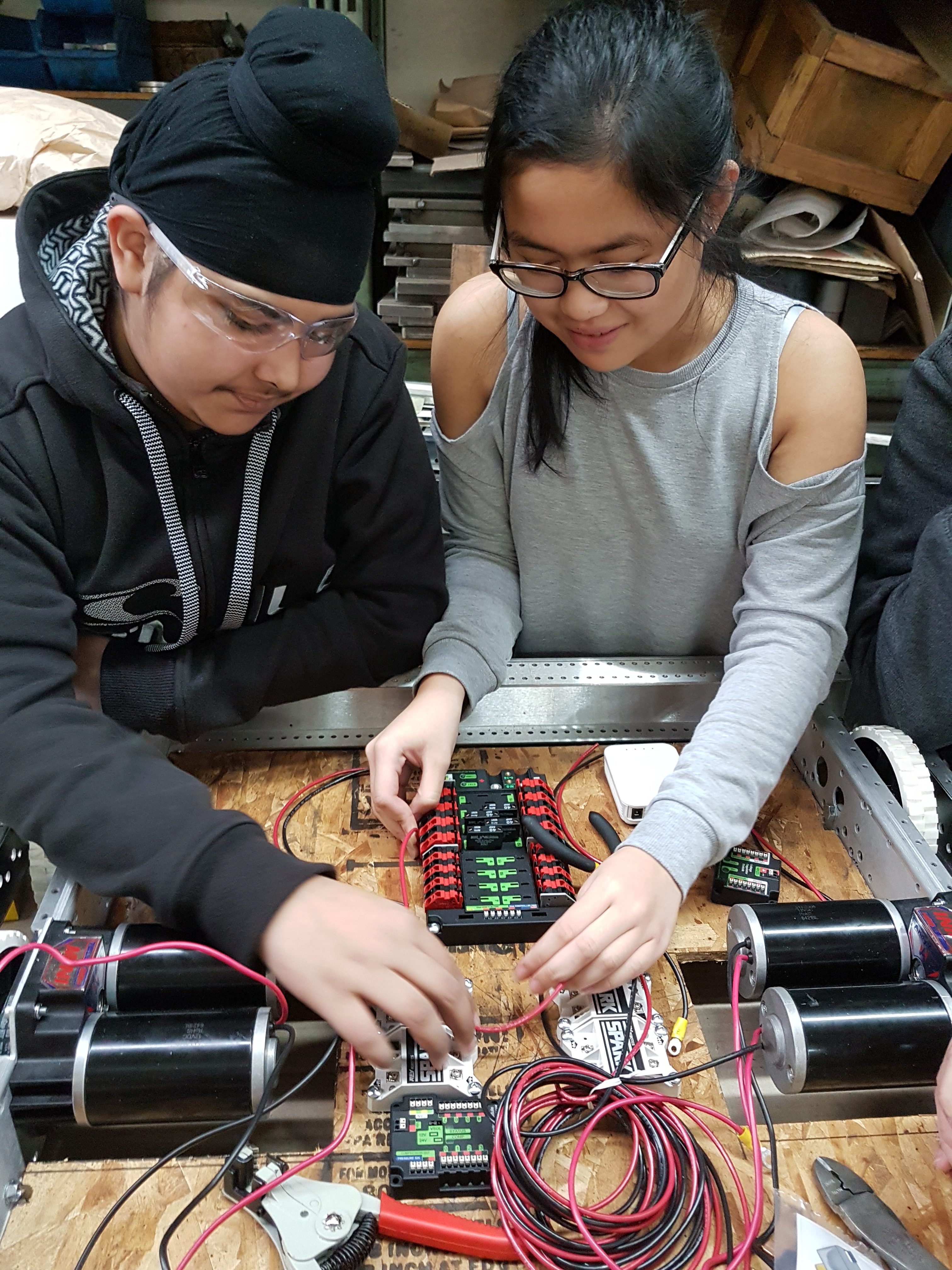Thank you to Microsoft for supporting FIRST Robotics Competition! Throughout the FRC season, we will get to know Microsoft-sponsored teams. This week we talked to FIRST team 6485, Mecha Mustangs from L.A. Matheson Secondary School in Surrey, British Columbia.
1. What makes your team unique?
Team 6485: Our team is unique for several reasons. Our high school is classified as an “inner-city” school and is located in a lower socio-economic area. We find creative ways to raise the funds needed to construct our robot and finance the travel of all our members to the tournament. Due to our lack of funds, we have to be very frugal with what we purchase in terms of tools and parts. Thankfully there have been schools that have generously donated a part or two when we have called on them for assistance.
Our next biggest hurdle has been where to build our robot and who will help us. We rely on sketches and manual work and our own knowledge to design and prototype our robot. Thankfully, our teacher mentor’s family owns a local machine shop where we can work to build our robot, primarily on the weekends, under the supervision of three incredible industry mentors who donate their time to assist our build team. They have patiently helped us learn the basic skills and techniques required to build our robot, and even inspired some of us to consider pursuing a career in the trades or in engineering. In terms of programming, our team has spent many hours on the internet watching tutorials, looking through forums reading other people’s questions and the response, and daring to risk embarrassment by asking our own. It has been amazing to see our knowledge grow.
Most importantly, our team is unique because of the people who are on it. We are proud of the way we interact with each other as we learn together and work on our robot. We are always supportive and encouraging and let every member have a voice and the freedom to make a contribution. Collectively, we have a natural sense of curiosity and a high level of commitment that allows us to push through our challenges and find effective solutions to our design issues. We have expanded our team to include Lego Boost robots and have two students with down’s syndrome who are part of our team. Unfortunately, they will not be travelling to Victoria with us. As a team, we have all become very good friends and feel that our teamwork is close to perfect. We are having a lot of great fun as we struggle together to build our robot.
2. What are your team initiatives to include diversity in STEM?
Team 6485: In recruiting members for our team, we work really hard to promote and showcase the possibilities of STEM and the FRC program to all of the diverse groups within our school. The L.A. Matheson Mecha Mustangs are a very multicultural team, with members, both male and female, coming from South Asian, Filipino, Japanese, First Nations, European, and Spanish backgrounds. We have also been very fortunate to be able to include 2 team members who have Down’s syndrome. This complete breadth of diversity is actually what makes us stronger and more well rounded. We encourage all students to participate in our program. We believe that opportunities should be open to anyone and everyone who is interested. We have worked hard to increase the involvement of females in our team. Having a female teacher mentor as a role model has been a real plus.
Now that build season is winding down, we are hoping that we will have the time to demonstrate our robot to fellow students in our school, our parents, to grade 5-7 students at our feeder schools, and at community events. We want to showcase all that we have learned and accomplished and encourage groups to support us. But most importantly, we want to follow the lead of some other FRC programs in our area and take a more active role in encouraging a diverse group of students to get involved, not only in robotics, but more importantly in STEM courses in general. We want all students to realize that they have some incredible opportunities to pursue education and careers in the area of STEM.
3. What is the most difficult part of this year’s game POWER UP and how will you handle that?
Team 6485: Last year was our rookie season, and unfortunately only four of our team members weren’t in grade 12. The result was that our team was left with virtually no programming experience and only limited build experience. It has been extremely challenging learning to use the encoders and gyros that will be necessary to control the robot during the 15 second autonomous period of each match.
In our opinion, there are two parts of the game that are the most challenging. To be able to contribute to all aspects of the game, a team needs a system that can raise cubes anywhere from a height of 3 inches to a maximum height of over 6 feet. In addition, to minimize weight, the same lifting or delivery system needs to be able to be used as a key part in the mechanisms that will allow the robot to lift itself 12 inches off the platform during the end game. To handle this, we have created a two-part lift system that can raise over 7 feet, yet can collapse low enough to fit within the frame perimeter allotments for the starting position and for the reach beyond the bumper zone. In designing our robot, we have had to be really concerned about the center of gravity and taking design and driving steps to minimize the chance of our robot falling over during the climbing period. We are planning ahead to bring some extra materials to the competition to solve balance issues once we see how the robot performs with the actual game pieces.
We also feel that strategy will be a key part of this year’s game compared to last year. Teams will need to work together to control possession of the scale and the switch, to maximize the acquisition and timing of power-ups, and to give each team the space they need to function effectively. Our strategy coach has worked with her team to develop what is going to be our “ideal” strategy, and to come up with alternate strategies that will help us build on the strengths and weaknesses of our alliance members. Prior to going to our competition, we hope to have the opportunity to watch the feeds of earlier competitions and to learn as much as we can from their experiences.
4. What are you most excited about for this year’s season?
Team 6485: There are many things our team is excited about, but we are most excited about our ability to climb and our use of pneumatics. Climbing was something that we struggled with last year. We went to Calgary without having the ability to climb and it wasn’t part of our game plan. Once there, we realized how vital climbing was to the success of an alliance. We spent a stressful 2 days tearing our robot apart between matches, rebuilding, and finally getting our robot to climb on the 2nd to last match. Although our team was overjoyed by our eventual success, and was rewarded with the Judge’s Award, the stress was incredible. This year, we set the bar much higher and worked hard to ensure that our robot could climb and successfully complete most aspects of the game before the end of build season. We know that we will be able to relax a bit more during the competition knowing that we can be useful to our alliances right from match one. We are also excited to see how our pneumatics system stands up to the rigors of competition. We are confident that our 2018 robot will be much more impressive than our rookie attempt. Mike, our technician and build captain, is looking forward to being a source for other teams rather than being the “person” in desperate need of programming help, design assistance, tools, and parts.
5. How has the Microsoft grant helped your team?
Team 6485: This is our second grant from Microsoft. Last year, we received a generous rookie grant that was used to pay a significant part of our entrance fees, purchase most of the parts for our robot, and finance all of the travel expenses to Calgary for more than half of our team. Microsoft’s generous support enabled us to focus our attention on the learning and building aspects of robotics. The funds ensured that we could participate and build a robot that we were all proud of. Equally important, the funds guaranteed that a family’s financial situation would not limit their child’s opportunity to participate in the robotics program or to travel to the competition. Although we had a wonderful time in Calgary and definitely wanted to continue with the FRC program, we knew that our second season would be exceptionally tough to fund. We considered dropping out of the FRC program, but Ian Koscielski, the Regional Director of British Columbia, came to our rescue and helped secure funding that would help guarantee our involvement in the program for a second year. The grant that Microsoft has graciously given us this year, has once again played a tremendous role in lifting some of financial burden on our team by helping to cover the registration costs for the season. As a result, we could focus our fund-raising efforts to purchase additional parts for our robot and financing our trip to Victoria. As a result, we will be able to reduce the amount of money our parents have to pay to send us to the regional completion in Victoria. We cannot begin to express our gratitude to Microsoft for their assistance in helping us stay involved in FRC.
Check out other Microsoft initiatives that are helping kids and youth obtain the necessary skills to participate in a world being transformed by technology.




